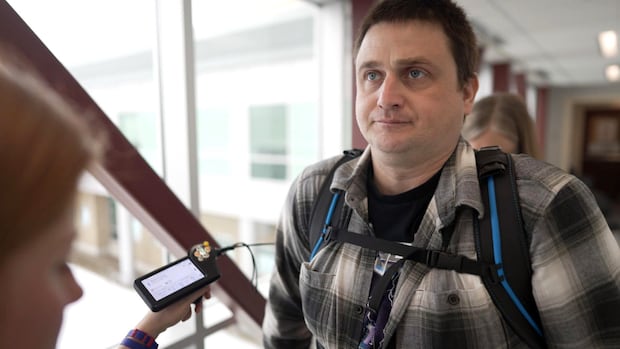How a device called an exoskeleton is helping one N.B. man get back on his feet
Josh Nevers, who has a spinal cord injury, using one for rehabilitation at Stan Cassidy Centre in Fredericton
After sustaining a spinal cord injury in a motor vehicle accident, Josh Nevers is learning to walk again, even though he doesn't have much feeling in his legs.
A patient at the Stan Cassidy Centre for Rehabilitation at the Dr. Everett Chalmers Hospital in Fredericton, one aspect of his physiotherapy sessions has especially made a difference: a robotic suit called an exoskeleton, or more fully, the EksoNR Robotic Exoskeleton.
"It feels pretty amazing to walk with it again because you're actually moving your legs like you are walking," Nevers said.
"I hope it gets me so I can use my leg braces again."

Physiotherapist Erica de Passillé said the exoskeleton is a battery-operated, wearable device that gives patients with minimal movement in their legs the ability to walk.
"It allows patients to take more steps than they otherwise could over ground," De Passillé said. "So it's a fantastic piece of technology."
The suit was purchased with a donation from the Chalmers Foundation, the Horizon Health Network said in a news release. The only other one in Atlantic Canada is owned by the University of New Brunswick, which had let the hospital use it since 2017, the release said.
Meghan Leroux, his other physiotherapist, said Nevers had no movement in his lower body and has had additional leg injuries in recent years.

"And so we're just trying to get him back to being able to walk within the home again and back to what he was doing," Leroux said.
She said they've been using this "cutting edge equipment" twice a week with Nevers to get him comfortable in a standing position. And it's been rewarding to see his growth.
"Especially when you have a goal that you're working toward, and you know that this is part of getting there and part of that journey, you know, and to get him back to where he wants to be," Leroux said.
Using the exoskeleton can help a patient eventually become more independent, De Passillé said.
"And the feeling of being able to stand up and take steps is like none other, especially if they haven't been able to in a while."
With files from Clare MacKenzie


